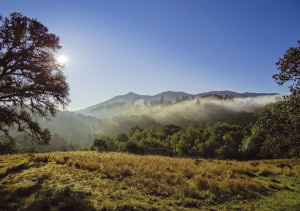n a Thursday morning last December, Alina Rainsford arrived at the Western wing of San Francisco’s Moscone Center to receive a presenter’s badge. The sprawling convention center was swarming with researchers – more than 22,000 of them – who had traveled from around the world to meet their scientific colleagues and present their findings at the American Geophysical Union’s weeklong national meeting. Rainsford, for the day, was one of them.
“At first it’s overwhelming, because you see all these people with extreme resumes,” Rainsford says. “I was so impressed with the knowledge in that room.”
Rainsford spent most of the day presenting to PhDs, professors and members of the press who clustered around her team’s display. The data, Rainsford explained, demonstrate a shift in the distributions of Endocladia muricata and Gelidium coulteri, known collectively as red algal turf algae, toward high tidal zones at Duxbury Reef in Marin. The research spans a decade, and provides compelling evidence that sea level rise is forcing species to migrate. After six hours of discussion, Rainsford ducked out of the conference early in the afternoon to return to her home in Mill Valley. The high school sophomore had to get started on her homework.
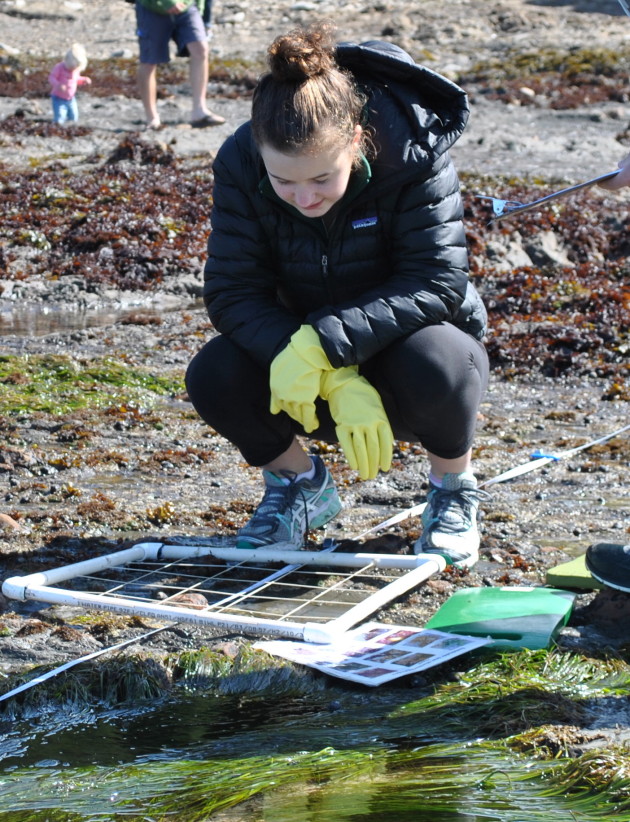
(Photo by Sabine Bergmann)
resenting at the world’s largest geophysical sciences gathering has become a remarkable commonplace for high school students in a program called “LiMPETS” – Long-term Monitoring Program and Experiential Learning for Students – which was created in 2002 by the West Coast’s National Marine Sanctuaries as a way to harness the power of citizen science to monitor intertidal and sandy beach ecosystems. After 12 years of study the database contains more than 1,000 surveys with population figures for 34 different types of algae and invertebrates at 70 different monitoring sites. It has engaged more than 4,000 participants in the monitoring effort; 60 percent of them, like Rainsford, are in high school.
And it’s real data, says Dr. John Pearse, a professor emeritus of ecology and evolutionary biology at UC Santa Cruz and president of the Society for Integrative and Comparative Biology. The program has shown the destructive path of sea-star wasting disease and demonstrated positive effects of marine protected areas. Groups in Hawaii, Alaska and Peru have modeled initiatives after it.
Rainsford’s high school, The Branson School in Marin, is one of LiMPETS’ most active schools. Students at Branson began monitoring Duxbury Reef through their own program in 1999. When, three years later, NOAA created LiMPETS, it turned to Kathy Soave, the chair of Branson’s science department, to help lead the initiative that her students were already calling Sustainable Seas.

oave looks exactly the same as she did when she taught me high school chemistry ten years ago: slender, with surfing-sculpted arms, a bob of curly hair, and a dash of marine-themed jewelry. Even her living room, adorned with curtains of shells and cluttered with dive gear for an upcoming trip, is homage to the sea.
The ocean enticed Soave from an early age. On family vacations she used to go tide pooling with her father before her siblings got out of bed. “It was cold and early, and no one wanted to go, but I loved it,” Soave remembers. “Ever since I’ve loved the ocean: love being in it, love being around it, love poking around in it.”
The trips to the coast animate her students, Soave says, just as tide pooling with her father excited her. “Getting out into the field leaves its mark,” Soave says. “It makes you care.”
Soave takes every chance she has to bring students with her to surf, dive and explore the ocean. In 1999, Soave found an opportunity to give those explorations some scientific rigor when she was named Teacher at Sea for the Farallones National Marine Sanctuary, and handed a mandate to engage her students with the ocean. Soave chose to monitor rocky intertidal ecosystems at Duxbury Reef. Duxbury had no ongoing permanent record of invertebrate and algae populations and Soave saw an opportunity for her students to be the first ones out there “taking the pulse of the rocky intertidal.”
Laure Katz, then a sophomore at Branson, remembers loving the idea: “As soon as Kathy brought up the idea of Sustainable Seas I was on board,” she says. As was Courtney Hart, another sophomore who had heard about Soave from her older siblings and volunteered immediately to help planning and design.
Soave worked with intertidal experts at the Farallones to develop the methodology and select indicator species that students could easily identify in the field. Katz and Hart recruited new members and taught them that methodology.
Fifteen years later, student leaders are still responsible for becoming experts in the field. Leaders teach their peers how to collect data from quadrats – PVC panels gridded with strings – and how to position those quadrats along two linear transects that stretch from shore to sea. They also make sure their peers don’t confuse a whelk (Acanthinucella spp.) with a turban snail (Chlorostoma brunnea/funebralis), or a limpet (Lottia spp.) with a pink acorn barnacle (Tetraclita rubescens). Leaders give new members a role to aspire to, and they help the group grow.
Hannah Bassett, who became a Sustainable Seas leader after Katz and Hart graduated, says she remembers Sustainable Seas becoming so popular by her senior year that Soave had recruited half a dozen student leaders to train its members. Sustainable Seas started recruiting new members at the beginning of the school year by hosting reef outings, where students would search the reef for tide-pool all-stars like octopuses and leopard sharks. Leaders began strolling campus in bright green sweatshirts with Sustainable Seas Leader splayed across the back, like football jocks displaying their Varsity sweaters. “We were pretty proud,” Bassett says.
Rainsford became a leader as a sophomore last year. “This is probably one of the most influential experiences of my high school career,” she says. She likes to emphasize to other members the importance of good data: how each contribution going into the database builds on 15 years of work and how the project’s success depends on upholding that tradition.
In 2002, the Farallones Marine Sanctuary Association appointed Dr. Jennifer Salzman, the director of outreach programs at Stanford’s School of Earth Sciences, to work with Pearse, Soave and other marine ecologists to expand coastal monitoring to the entire west coast, and LiMPETS was born.
For Soave, who still leads the program, it’s a high school teacher’s dream: she has made her subject cool.
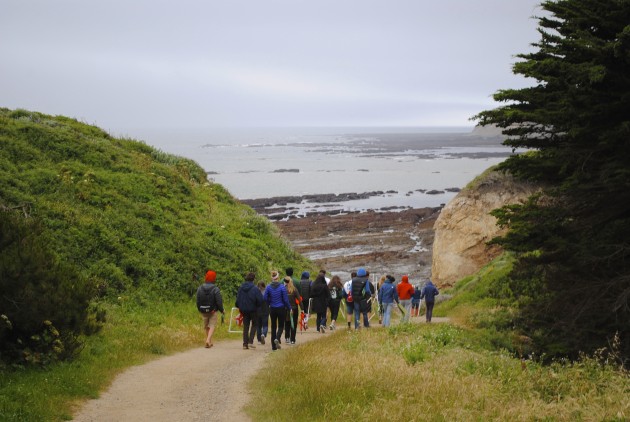
t 9 a.m. on a Sunday, in the Duxbury Reef parking lot, two-dozen teenagers climb out of school vans that Soave has borrowed from the sports department. Piled in the trunks of the vans are quadrats, tape measures and knee-pads. The sky is whitewashed with fog and a brisk, salty wind creeps up on the students, who will spend the next two hours crouched along two 65-meter transects.
Two students walk out to the reef’s edge with compasses, hunting amongst the algae-swathed rocks for transect markers: pink ropes no longer than a human hand. Once the transect lines are set, the other students file out along the reef in pairs. Within minutes the students are kneeling at their quadrats, noses mere inches from the seaweed, meticulously counting.
Soave floats amongst the groups, checking on their progress, occasionally pointing out novel species: six armed sea stars, skittery crustaceans. After about an hour the sun pokes through the fog and the students shed some layers. They make their way slowly toward the shore, the ocean creeping in behind them. Soave has described tide-pooling as being on the edge of the world. Today, the edge of the world is calm.
The sun brings visitors to the reef: couples, mostly, with their children toddling along the rocks. A man who looks to be in his mid-thirties approaches Rainsford to ask what she is up to. Rainsford speaks animatedly, gesturing to the quadrat, the species identification cards and the data sheets. At one point she points up and down the transect at her fellow students, who are deep in concentration or engaged in wind-silenced conversations. None of them look up.
he LiMPETS data has proven to be illuminating. A striking example is how the data has shed light on the spread of sea-star wasting disease. In late 2013, the disease decimated sea star populations along the west coast of North America, but the LiMPETS data shows a decline of populations for 3-5 years leading up to the main event. The finding indicates that wasting disease may have infected sea star populations long before their mass mortality.
The longevity of the LiMPETS data set allows scientists to look at long-term population trends. In the case of sea stars, the early stages of the wasting disease have come to light, but so may sea star recovery. And the data is comprehensive enough that the impact on mussels, major prey for sea stars, can also be tracked.
There are policy implications in the data as well. One of the objectives of marine protected areas (MPAs) is the protection of local species. Several marine reserves along the California coast regulate human harvest of rocky intertidal invertebrates, for instance, and the LiMPETS data demonstrate which of these species appear to have benefited from that protection. Owl limpets have higher population numbers inside marine reserve boundaries than outside them, even when the distance between monitoring sites is less than a mile. For mussels and turban snails, however, MPA benefits aren’t as obvious.
In an age when finding funding for long-term monitoring is difficult at best, data sets of a decade or more are few and far between. LiMPETS has reached the 12-year mark, and Soave’s team is entering year 15 of data collection. “I hope it will go on forever,” Soave says.
The size and time-span of the LiMPETS data set is only as good as its accuracy, and while citizen scientists have a questionable reputation for rigor, a paper published in 2005 by Pearse and his colleagues showed that students perform just as well as the professionals. When species surveys from both LiMPETS and the professional Partnership for Interdisciplinary Studies of Coastal Oceans are shown side by side, the results are almost always directly comparable.
“These results give us confidence that our monitoring program can provide reliable data that are suitable for use by resource managers,” the report concludes.
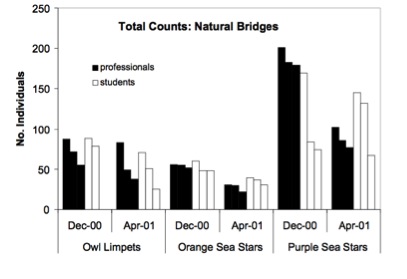
any of its creators consider LiMPETS proof that accurate citizen science groups can contribute data to research. Soave says her Branson students are dedicated to learning the species they see. “In fact,” she says, “kids this age are heads and tails better than any adults I have ever trained.”
Soave’s group takes double data sets on each transect they monitor, and the results show that her group is overwhelmingly consistent.
Amy Dean, FMSA’s education manager and a LiMPETS outing leader, says that citizen science groups have the potential to add volumes of environmental data to scientific databases. While most professional research teams monitor a few times a year, Dean says LiMPETS outings happen upward of 35 times a year.
Though student groups from LiMPETS have presented rocky intertidal population trends at AGU conferences since 2003 (abstracts are available here), they have barely scratched the surface of potential scientific analysis. LiMPETS produces much more data than there are academics willing to analyze it.
“We need to have people who can evaluate and manage our data,” Pearse says, “and further publicize the trends that we find.”
Amy Frietag, a science integration fellow at the California Ocean Science Trust, says that the AGU presentations, along with the success of the MPA monitoring data, have given LiMPETS some traction in scientific circles, though “not to the degree of well-known and respected professors.”
Pearse says the best way to attract the kind of collaboration that could reveal the scientific stories lying in the database would be for LiMPETS and other citizen science groups to publish their findings in peer-reviewed science journals. But publication is easier with scientific collaboration, which puts LiMPETS in a chicken-or-egg conundrum.
Time, though, is on the program’s side. As it stretches into its second decade, a new generation of professional scientists comes to work with personal experience in citizen science. Take Courtney Hart, Laure Katz, and Hannah Bassett for instance. The early Sustainable Seas leaders each went on from Branson to study marine science.
Hart is now getting a master’s degree in marine physiology after working as an environmental planner, fisheries biologist and watershed researcher. “I am a huge proponent of citizen scientists,” she says. “Collecting field data requires tremendous effort and I see the general public as a hugely untapped resource… [I’ve] always tried to get my peers in academia and business to create programs that use citizen volunteers as a resource.”
Katz directs large-scale marine initiatives for Conservation International, and recently helped launch a community fisheries monitoring program in Indonesia. The program depends largely on “highly trained community members” who Katz describes as a hybrid between citizen and professional scientists.
“I think that the experience of helping to set up and lead [Sustainable Seas] at a young age instilled in me an appreciation of the importance of long-term monitoring and an understanding of how participation in such a program can help connect you to your environment,” Katz says.
Bassett spent four years working in whale acoustics before moving to the Small-scale and Artisanal Fisheries Research Network, and is applying to PhD programs to further study small-scale fisheries. She remembers presenting data at AGU as one of the highlights of the program. “It was really thrilling for us to see what was done with science outside of our high school bubble,” she says.
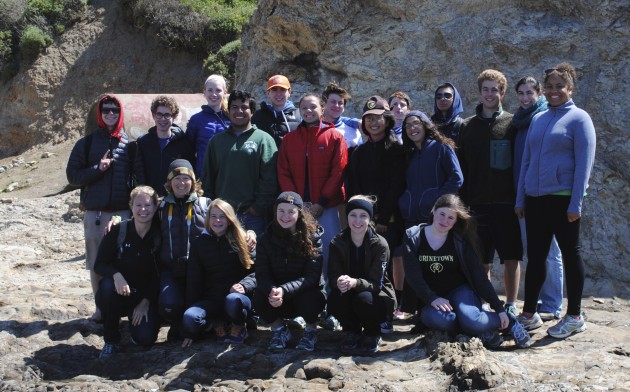
ssessments of LiMPETS participants show that students leave the program with an increased interest in science as a career. Like Rainsford, who among the swarms of researchers at the AGU conference last December, found herself stepping into the polished shoes of a professional scientist.
“It’s what I had always dreamed of doing,” Rainsford says. “You know: putting on tights and a suit and walking into a conference. I felt so professional! Our data was going somewhere; it was making a difference, which made me feel … incredible.
“I imagine,” she added, “that’s what a scientist feels like every day.”



